New products at Crocus
by Sarah - October 20th, 2010.Filed under: Crocus, New Products.
New items at Crocus
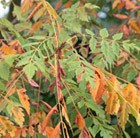
china tree £39.99
Position: full sunSoil: fertile, well-drained soilRate of growth: averageFlowering period: July to AugustHardiness: fully hardyThe big, pinnate foliage of this decorative tree, emerges in spring a pinkish-red before turning green as it matures. In autumn it changes colour once again, but this time to a buttery yellow before it falls. Added to the showy leaves, large, pyramid-shaped clusters of small yellow flowers appear from midsummer, creating a further blaze of colour.Garden care: Requiring little pruning, except to remove dead or damaged branches, however this should only be tackled in winter when the plant is fully dormant.
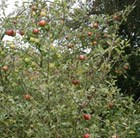
apple – family £39.99
Position: full sunSoil: fertile, well-drained soilRate of growth: average to fast-growingUltimate size on M26 rootstock: 3 x 3m (10 x 10ft)Flowering period: April and MayOther features: delicious dessert applesHardiness: fully hardyPollination Group: B – flowering mid seasonThese great ‘family’ trees have three diiferent varieties of dessert apples grafted onto one rootstock, so are perfect for smaller gardens where it may be difficult to find space for pollinating partners. Needless to say, come the autumn, it will be a real treat to enjoy a selection of tasty apples that you have grown yourself. This tree bears the following varieties: ‘Queen Cox’ – this is regarded by most as one of the best eating apples. They have a superb flavour and aroma with crisp and juicy flesh. Ready to harvest in September. ‘Falstaff’ – masses of pure white, cup-shaped flowers in mid and late spring, followed by crisp, juicy, red-flushed, dessert apples which should be harvested in October. The fruits store well until the following March. ‘Fiesta’ – another new variety that is also known as ‘Red Pippin’. It has been bred from ‘Cox’, so has many of its good features, without any of the problems. Ready to Harvest in October.Garden care: Keep the base of the tree weed free, fertilise at the beginning of each year and water regularly during hot, dry spells. Remove damaged or crossing branches during the dormant season.Pollination Information: As these trees are made up of several different varieties that can cross pollinate freely, you will not need another pollinating partner.
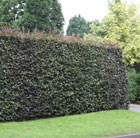
copper beech – hedging range £29.99
Position: full sun or partial shadeSoil: tolerant of a wide range of well-drained soilRate of growth: quite fast-growingFlowering period: April to MayFlower colour: insignificant separate male and female flowersOther features: makes an impressive purple-foliaged hedgeHardiness: very hardyTo find out more about how to plant a hedge, click hereA splendid tree with purple leaves that turn a rich copper in autumn. As a tree it is only suited to large gardens or parks, grown as specimens in the lawn. However, it does make a superb hedge, retaining the brown leaves through winter and only loosing them when the new foliage appears in spring. It will make a lovely formal hedge that also acts as an excellent windbreak.Garden care: Requires minimal pruning if grown as a tree, removing any broken, diseased or crossing branches in late autumn or winter. Trim as a hedge in August, but any renovative pruning needs to be done in early spring. When planting incorporate lots of well-rotted garden compost in the planting hole and stake firmly.
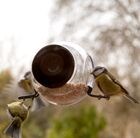
sphere-window-bird-feeder £12.99
Birds and lovers of good design will flock to this award winning bird feeder! Manufactured from recyclable plastic, it can be mounted on any smooth window pane, thanks to an innovative double-sided suction cup. The carefully selected materials can cope with extreme temperatures as well as UV rays. It is designed for small birds and features a drainage hole at the base of the bowl.Diameter 11.5 cm

winter windflower blue-flowered £9.98
Buy 50 Bulbs and Get another 50 FREE.Position: full sun or partial shadeSoil: well-drained, humus-rich soilRate of growth: fast-growingFlowering period: March to AprilFlower colour: blueHardiness: fully hardyBulb size: 4/5This is a wonderful plant that produces cheerful, daisy-like flowers in shades of blue and purple in March and April. These are perfect plants for naturalising in a mixed border around the base of deciduous shrubs, or adding spring colour to the edge of a woodland garden. For maximum impact, plant in bold drifts in September or October, and if happy, they should spread quite quickly.Garden care: Soak the tubers overnight in cool water and plant them (it doesn’t matter which way up) 5cm deep and 5cm apart. Ideally you should choose a spot where they can be left undisturbed so they can naturalise and spread.
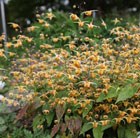
barrenwort £8.99
Position: partial shadeSoil: humus-rich, moist, well-drained soilRate of growth: slow-growingFlowering period: March to MayFlower colour: orange-yellowOther features: the leaves are valuable for winter flower displaysHardiness: fully hardyWiry, branching, near-black stems carry nodding, spurred, orange-yellow flowers from early spring, above the neat clumps of semi-evergreen, heart-shaped foliage. Ideal for underplanting in a woodland setting, or for filling gaps at the front of a partially shaded border. Tough and easy to grow.Garden care: In early spring remove dead and damaged leaves before the flowers appear and apply a thick mulch of compost or well-rotted compost around the crown of the plant. Lift and divide large clumps in autumn.

windflower £6.99
Position: full sun or partial shadeSoil: moist, fertile, humus-rich soilRate of growth: fast-growing Flowering period: April to MayHardiness: fully hardySprays of semi-double, cupped white flowers with purple centres appear from April to May set among pretty, ferny leaves. The flowers are large — 4cm across – compared to the size of the plant, and each has a lilac-blue underside. Its low growing, and perfect for the edge of a woodland or in a rockery. Like most anemones, it can tolerate a wide range of soils but prefers moist, fertile soil.Garden care: Apply a generous 5-7cm (2-3in) mulch of well-rotted garden compost or manure around the base of the plant in spring. Avoid moving the plant since it resents disturbance. Where necessary lift and divide congested clumps in early spring.
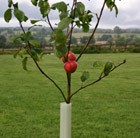
easy-wrap-rabbit-tree-guard £1.99
Made from UV stabilised polypropylene, Easy-Wrap Treeguards are great value for the gardener. They have a tremendous strength- to-weight ratio enabling them to be pushed into the soil during installation.They protect saplings and young trees from harsh weather, pets, rabbits, deer, strimmers, mowers and herbicides. An easy to install wrap-around design that takes seconds to fit, with no need to tie on to a stake.

Dahlia £1.49
Position: full sunSoil: fertile, humus-rich soilRate of growth: average Flowering period: July to September Flower colour: bright vermilion-redOther features: excellent cut-flowersHardiness: half hardyStriking, semi-double, bright vermilion-red flowers from July to September and deeply divided, dark bronze-red leaves. This popular, peony-flowered dahlia requires a sunny site with fertile, humus-rich soil. Perfect for a planting scheme based on ‘hot’ colours, the tubers must be lifted and over-wintered in a frost-free place in all but the warmest areas.Garden care: Provide a high-nitrogen liquid feed each week in June, then a high-potash fertiliser each week from July to September. Once the first frosts have blackened the foliage carefully lift and clean the tubers and allow them to dry naturally indoors. Place the dry tubers in a shallow tray, just covered with slightly moist potting compost, sand or vermiculite. Store in a frost-free place, checking frequently over the winter months
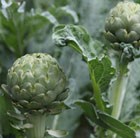
artichoke £1.09
Position: full sunSoil: humus-rich, moisture retentive soilA large and striking perennial vegetable with silvery-green deeply toothed leaves that’s good-looking enough to grow in the ornamental garden. The spiky flower buds are cut from summer onwards, with each plant producing up to 10 artichokes a season. The plant stays productive for many years given a free-drained soil and a sunny spot.Growing Instructions: Sow from late February in a greenhouse or on a sunny windowsill in pots of freely-draining seed compost and keep at 15C. Grow on young seedlings and plant out where they are protected from strong winds in early summer – adding some grit to the planting hole to improve drainage if you have heavy soil. Remove any chokes which form in the first year, and protect crowns with leaves or straw against frost in winter. Start harvesting artichokes in the second season.Sow: Feb AprHarvest: June – SeptApproximate quantity: 40 seeds.






